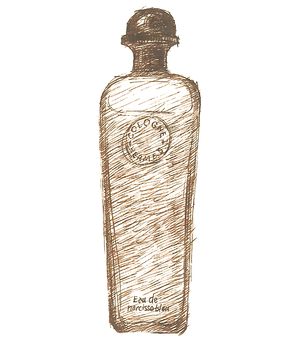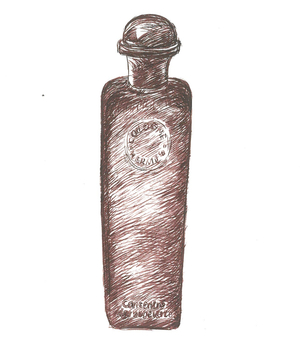Tagged With ‘sour-sweet’
Hermès
Eau de Narcisse Bleu
10 October, 2014
 Pretty much everyone I know loves Hermès’ deliciously fresh and zingy Eau d’Orange Verte, so when Eau de Narcisse Bleu (literally ‘blue narcissus water’) was launched in 2013 it had a tough act to follow. As I’ve never seen a blue narcissus / daffodil, I think it’s safe to say that this perfume has an element of fantasy about it, and as a smell, too, it’s perhaps rather more complex and a little less instantly accessible than its predecessor. But give it a little time and I think it’ll grow on you.
Pretty much everyone I know loves Hermès’ deliciously fresh and zingy Eau d’Orange Verte, so when Eau de Narcisse Bleu (literally ‘blue narcissus water’) was launched in 2013 it had a tough act to follow. As I’ve never seen a blue narcissus / daffodil, I think it’s safe to say that this perfume has an element of fantasy about it, and as a smell, too, it’s perhaps rather more complex and a little less instantly accessible than its predecessor. But give it a little time and I think it’ll grow on you.
Eau de Narcisse Bleu may not have the euphoric mood-lifting freshness of Eau d’Orange Verte, but it has a gentle softness that, once you’ve smelled it for a while, is extremely appealing in its own right. It does have the faint sweetness of real daffodil flowers (try sticking your nose in one on a sunny day next March and you’ll see what I mean), but what narcissus extract smells of most, rather unexpectedly, is fresh hay. *
Now, I have nothing against smelling of hay, which is a lovely scent in its own right, but what Hermès’ much-mythologised perfumer, Jean-Claude Ellena, has done is blended the smell of hay with a whole raft of subtly complementary fragrances. Most of them are quite ‘green’ – that is, they smell fresh and natural, like grass and leaves, but not especially sweet or flower-like.
To me it has a slight but definite scent of fig-leaves, which for anyone who loves L’Artisan Parfumeur’s wonderful Premier Figuier as much as I do can only be a good thing. Whether this figginess is (excuse the pun) a figment of my imagination I’m not sure, but among the other ingredients that Ellena lists is galbanum, which is extracted from the root of a wild Iranian plant that looks a bit like fennel or cow-parsley, and indeed is distantly related to them.
Galbanum has a marvellously fresh sappy smell like newly-snapped pea-pods, and is one of the most important components of ‘green’ perfumes, but its greenness, here, is tempered by the hay-like sweetness of narcissus, with a hint of earthy bitterness underneath which manages to stop it from smelling at all girly.
If my description makes it sound a bit complicated, don’t be put off, for it’s such a well-blended perfume that there’s nothing discordant about it. In fact if anything it is, perhaps, a little too gentle for its own good, as it’s a ‘quiet’, thoughtful scent that stays close to your skin and doesn’t, on the whole, grab other people’s attention. It’s discreet and refined, in other words, rather than a ‘look-at-me’ perfume, which is perfect if you want to smell good without drawing attention to yourself. Go try it.
* I say ‘narcissus extract’, but one of the irritating things about perfume marketing is how vague – and frankly clueless – most descriptions of perfume ingredients actually are. For as anyone who actually grows the things themselves knows full well, a bright-yellow daffodil like Narcissus ‘February Gold’ smells very different to Narcissus papyraceus, the so-called paperwhite narcissus; the former has a gentle, hay-like scent, while one of the big selling-points of paperwhites is their powerful, almost jasmine-like perfume, the sweetness of which, en masse, can have a touch of the slightly repellent stagnant-water smell that perfumers refer to as ‘indolic’. If only perfume PRs were taught some basic botany.
Postscript – mystery solved, but only by going to the source: in France last week I visited IFF-LMR, the legendary natural raw perfume materials company near Grasse, and what should we get talking about but their narcissus extract, which is derived from the beautiful Narcissus poeticus, fields of which grow wild in the uplands of the Lozère. Did they use other species of daffodil as well? No, came the answer, and it’s their extract that you’re smelling (among many other things) in Eau de Narcisse Bleu.
Hermès
Concentré d’Orange Verte
18 July, 2014
 In 1979, Hermès launched a brilliant take on the classic men’s eau-de-cologne. Simply called Eau de Cologne d’Hermès, it was created by Françoise Caron, who you could almost say had perfume in her blood. Born in the one-time capital of French fragrance, the Provençal town of Grasse, into a family that worked in the perfume trade, both she and her brother, Olivier Cresp, became highly regarded professional perfumers in their own right.
In 1979, Hermès launched a brilliant take on the classic men’s eau-de-cologne. Simply called Eau de Cologne d’Hermès, it was created by Françoise Caron, who you could almost say had perfume in her blood. Born in the one-time capital of French fragrance, the Provençal town of Grasse, into a family that worked in the perfume trade, both she and her brother, Olivier Cresp, became highly regarded professional perfumers in their own right.
Many perfumes are variations on a theme, and the fresh, citrusy scent of eau-de-cologne is probably the best-known theme of all. But some variations are more interesting and successful than others, and Françoise Caron’s master-stroke was to turn up the volume, if you like, on a single ingredient – bitter orange – that plays a subsidiary role in most colognes.
The effect is delicious and bracingly sour-sweet, like a proper old-fashioned lemonade, but because orange is a more powerful, complex citrus scent than lemon it has far more depth and staying power. Françoise Caron also included mint (which adds a minor cooling touch), as well as lime and blackcurrant buds – which, if like me you have blackcurrant bushes in your garden, you’ll know have an intriguing scent, both sweet and slightly foxy.
Eau de Cologne d’Hermès continued in production until 1997, when Hermès changed its name to the slightly more individual Eau d’Orange Verte, though the scent remained the same. One criticism of Caron’s original perfume was that it didn’t last very long, and presumably as a response to this, in 2004 a concentrated version was released, tweaked by in-house perfumer Jean-Claude Ellena and helpfully called Concentré d’Orange Verte.
It’s this version I like best, I suppose because it seems to have retained all the character of Françoise Caron’s original yet packs a rather more powerful punch, and on my skin at least it certainly seems to last a good hour or two. It’s a zesty, uplifting and – I’d say – a happy scent, and one that I’d happily wear every day. Perfect for lifting the spirits on a dull grey Monday morning.